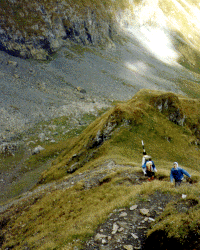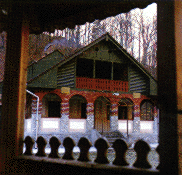| Gastronomy: Although
international cuisine is available in better quality restaurants, make
sure that you savour the local Craiovean dishes. Romanian cooking is rich,
tasty and substantial, as befits a country were all food is still naturally
grown, where fruits and vegetables follow their normal season, and when
the winter is cold.
Pork is a special favorite, but you will find good beef, veal, and chicken too. They are delicious simply grilled. Typical Romanian specialties include a range of soup – " ciorba ", a sour soup made from fermented bran , bacon, potatoes and beef or chicken. Hearty stews such as " Tachitura Moldoveneasca " are accompanied like many Romanian meat, and " Mititei " is small grill sausages perfumed with aromatic herbs. Among Fish dishes sample carp on the spit, a local specialty in the Danube Delta. A range of excellent white and red Romanian wines of the famous vineyards of Murfatlar, Cotnari, Jidvei, Dealu Mare, Odobesti, Valea Calugareasca, accompany local and international dishes to perfection, while " Tuica " the local plum brandy is often drunk as a digestive. But beware, it carries a sting in its tail! The local beers are excellent. Eating out: Here are some prices for local meals you can enjoy:
Hunting: The open season for hunting is: stag (01/08-03/1 ); roebuck (01/05-31/10); deer (01/09-30/11); chamois (15/09-31/12); wild boar (01/10-15/02 ); mountain cock (¼-15/05 ); pheasant ( 15/10-28/02 ); water birds ( 15/08-15/03 ). Romania is one of the four countries that founded the International Council for Hunting and Game Protection.
Shopping: Interesting purchases to make in Romania are embroidered table cloths and table napkins, ceramics, pottery, carpets, folkloric, wood, porcelain, silverware and icons. Normal shopping hours are 8.00 a.m. to 6.00 p.m., but shop and department stores are pen till 9.00 p.m. and later. Duty free shops are to be found in the international airports. Museums: – the
Art Museum ( paintings, sculptures, tapestries, icons, etc. );the
History Museum, the Museum of Oltenia County , the Art Collections Gallery
( the most voluble private arts collections ), the Firemen Museum
the Military Museum…
Folklore: Romanian folklore is best preserved in the world and examples can be found all over the country. Maramures ( wooden architecture, costumes ceramics ), Bucovina woven materials, Easter painted eggs, costumes, traditions, Horezu ( potery, wood carving ), the Apuseni Mountains ( popular costumes, wood corving, folk celebrations, wooden architecture ), Marginimea Sibiului ( glass painted icons, popular costumes, houseware – all gathered in ethnographic museums ). Also museums housing ancient peasant techniques in Bucharest, Sibiu, Cluj – Napoca, Ramnicu Valcea, Focsani, Timisoara, Sighetul Marmatiei. Folk music and dancing is a vital, living tradition in Romania. Skows can be seen in many hotels and restaurants throughout the country. Romanian folk music is by turns rousing and haunting, you will find it hard to resist.
Traditional architecture: Traditional
peasant houses are normally small and picturesque, blue trimming frequently
contrasting colorfully with whitewashed walls in certain parts of the country,
multicolor versions in others. Porches and overhanging eaves are a commonly
found feature everywhere. Furniture, curtains, rugs and clothing are often
handmade!
|
 Sports:
. Tennis, badminton, volleyball, handball,
football, basketball, bowling and billiards are very popular in Craiova.
Sports:
. Tennis, badminton, volleyball, handball,
football, basketball, bowling and billiards are very popular in Craiova.
 Fishing:
Fishing may be practiced mainly in the Danube, Jiu and on the lake
shores around big cities ( observing legal requirements ). In the Danube
where are over 160 fish species, fishing may be combined with excursions
for professional and amateur ornithologists ( the Danube Delta shelters
over 300 bird species and the biggest colony of pelicans in Europe ).
Fishing:
Fishing may be practiced mainly in the Danube, Jiu and on the lake
shores around big cities ( observing legal requirements ). In the Danube
where are over 160 fish species, fishing may be combined with excursions
for professional and amateur ornithologists ( the Danube Delta shelters
over 300 bird species and the biggest colony of pelicans in Europe ).
 Night
life: A meal in a restaurant or hotel, with
floorshow, is an excellent way of spending a Romanian evening. If you want
" to go on " there are nightclubs and discotheques in Craiova as Gin-Gin
or Aristocrat.
Night
life: A meal in a restaurant or hotel, with
floorshow, is an excellent way of spending a Romanian evening. If you want
" to go on " there are nightclubs and discotheques in Craiova as Gin-Gin
or Aristocrat.